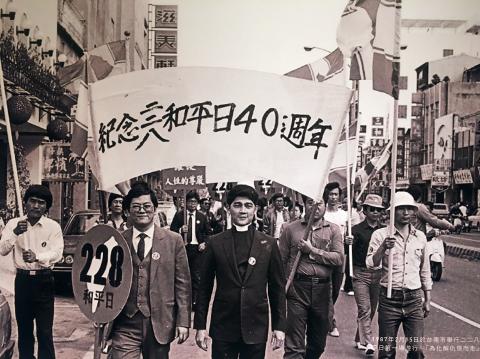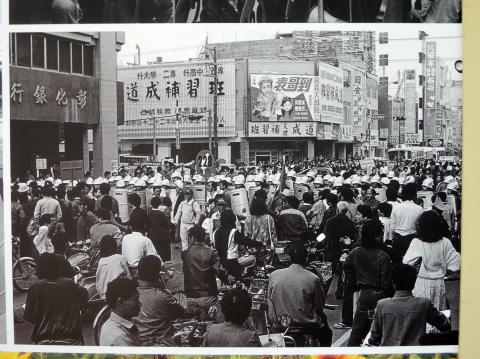Feb. 27 to March 5
“Today, the family of the victims will listen with their own ears as I, as a public servant of the country, accept the responsibilities of the government’s past mistakes and offer my deepest apologies.”
These words were part of the speech by then-president Lee Teng-hui (李登輝) on Feb. 28, 1995, the 48th anniversary of the anti-government uprising and subsequent brutal crackdown that would be known as the 228 Incident.

Photo: Hung Jui-chin, Taipei Times
It was the first time a president officially addressed the incident, much less apologized for it, as the incident had remained a taboo subject well into the 1980s. Even after the lifting of martial law, artist Chan San-yuan (詹三原) was reportedly jailed (under other pretenses) for designing Taiwan’s first 228 memorial monument in Chiayi in 1989.
CENSORING 228
To understand the extent the incident was “erased” from public memory, communications professor Hsia Chun-hsiang (夏春祥) analyzed news reports from the Taiwan Shin Sheng Daily News (台灣新生報), United Daily News (聯合報) and China Times (中國時報) between 1947 and 2000.

Photo: Hung Jui-chin, Taipei Times
Between 1948 and 1957, only four news articles mentioning the 228 Incident appeared in these papers, all of them appearing in the government-run Taiwan Shin Sheng Daily News. One of these detailed the punishments for those involved in the uprising, and the other three were direct reports on notable people involved with the incident.
After 1957, the 228 Incident disappeared from these papers for 27 years until the United Daily News published a feature on the history of the Central News Agency, which mentions how staff members reacted during the incident.
In 1985, legislator Chiang Peng-chien (江鵬堅) requested that the government acknowledge and apologize for the incident, suggesting that they designate Feb. 28 as “Peace Day.” The Executive Yuan did not respond and major newspapers did not report on the matter.
Two days before the 40th anniversary of the event in 1987, the first critical article appeared in the United Daily News, a column by historian Hsu Cho-yun (許倬雲) asking the government to directly address and resolve the “228 tragedy.”
Martial law was lifted a few months later, and freedom of speech began to return. By 1992, a United Daily News poll showed that 80 percent of respondees knew about the incident.
INTO THE SPOTLIGHT
Despite official censorship, Taiwanese kept the memory of the 228 Incident alive in private. And since the 1950s, independence activists working in Japan and the US continued to make the incident one of their talking points.
According to the article The Predicament of Historical Justice: Ethnic Issues and the Discourses on the 228 Uprising by historian Chen Tsui-lien (陳翠蓮), overseas Taiwanese published books in 1983 and 1984 that heavily criticized the KMT’s handling of the events.
The government dismissed these authors as instigators who were reopening old wounds to advance their independence agenda. They decided to write their own book, which contained the following passage:
“After the incident, the government and people both stopped talking about the events because of how painful it is to everyone …We only hope that time can wash away these horrific memories and people can stop debating which facts are true and who was in the wrong ... Otherwise it will only disturb our peaceful life as a united people. These overseas groups bring this event up each year to slander the government and distort the truth.”
In February 1987, local activists started the 228 Peace Day Association ( 二二八和平日促進會) and started holding memorials all over the country. Although riot police were sent to stop them, the activities continued. Chen writes that the government at this point finally realized that they could no longer brush the incident aside.
At first, officials continued the rhetoric of “needlessly reopening old wounds,” but after the end of martial law, more legislators spoke out and the media reports only continued to increase, although Chen writes that much of the content echoed that of the government.
When Lee became president in 1988, he too stated that people should bury the hatchet and look toward the future instead of the past. By 1990, his stance had changed, establishing a 228 Incident Task Force and allowing the events to be included into high school textbooks for the first time.
However, the family of the victims and 228 activists were not satisfied especially because their calls for the government to formally apologize were repeatedly denied.
After his 1995 apology, Lee added that this was just the beginning.
“We can’t be satisfied with building this monument,” he said. “We need to publicize the truth behind the events, compensate the victims, designate a memorial day, and also heal our people’s spirits and rebuild their dignity. These will all happen in the near future.”
Taiwan in Time, a column about Taiwan’s history that is published every Sunday, spotlights important or interesting events around the nation that have anniversaries this week.

Many people noticed the flood of pro-China propaganda across a number of venues in recent weeks that looks like a coordinated assault on US Taiwan policy. It does look like an effort intended to influence the US before the meeting between US President Donald Trump and Chinese dictator Xi Jinping (習近平) over the weekend. Jennifer Kavanagh’s piece in the New York Times in September appears to be the opening strike of the current campaign. She followed up last week in the Lowy Interpreter, blaming the US for causing the PRC to escalate in the Philippines and Taiwan, saying that as

US President Donald Trump may have hoped for an impromptu talk with his old friend Kim Jong-un during a recent trip to Asia, but analysts say the increasingly emboldened North Korean despot had few good reasons to join the photo-op. Trump sent repeated overtures to Kim during his barnstorming tour of Asia, saying he was “100 percent” open to a meeting and even bucking decades of US policy by conceding that North Korea was “sort of a nuclear power.” But Pyongyang kept mum on the invitation, instead firing off missiles and sending its foreign minister to Russia and Belarus, with whom it

The Chinese Communist Party (CCP) has a dystopian, radical and dangerous conception of itself. Few are aware of this very fundamental difference between how they view power and how the rest of the world does. Even those of us who have lived in China sometimes fall back into the trap of viewing it through the lens of the power relationships common throughout the rest of the world, instead of understanding the CCP as it conceives of itself. Broadly speaking, the concepts of the people, race, culture, civilization, nation, government and religion are separate, though often overlapping and intertwined. A government

Nov. 3 to Nov. 9 In 1925, 18-year-old Huang Chin-chuan (黃金川) penned the following words: “When will the day of women’s equal rights arrive, so that my talents won’t drift away in the eastern stream?” These were the closing lines to her poem “Female Student” (女學生), which expressed her unwillingness to be confined to traditional female roles and her desire to study and explore the world. Born to a wealthy family on Nov. 5, 1907, Huang was able to study in Japan — a rare privilege for women in her time — and even made a name for herself in the